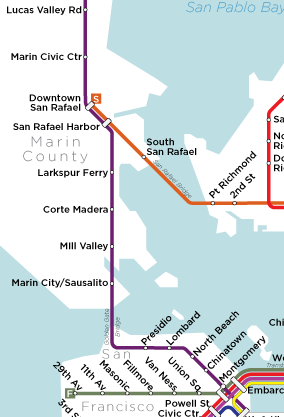 Marin's downtowns are rich, vibrant places, but they're typically seen as historic shopping districts rather than places to live and work - Downtown San Anselmo is not considered to be the same as The Flats, although they are literally on the same blocks. When redevelopment peaks its head out, it becomes lost in a sea of parking (as in the San Rafael Corporate Center), gets stymied by illogical density limits (as in the Second & B Monahan proposal), or dumbed-down by developers that see Marin as just another suburb (as in Larkspur's Rose Garden development). Few bold developments do get built in our town centers, and the most important one of late - Novato's Millworks - is perceived as a failure despite low vacancies.
Marin's downtowns are rich, vibrant places, but they're typically seen as historic shopping districts rather than places to live and work - Downtown San Anselmo is not considered to be the same as The Flats, although they are literally on the same blocks. When redevelopment peaks its head out, it becomes lost in a sea of parking (as in the San Rafael Corporate Center), gets stymied by illogical density limits (as in the Second & B Monahan proposal), or dumbed-down by developers that see Marin as just another suburb (as in Larkspur's Rose Garden development). Few bold developments do get built in our town centers, and the most important one of late - Novato's Millworks - is perceived as a failure despite low vacancies.
One reason this might be is due to residents' perceptions of urban living. Many Marinites are San Franciscans who left the city in the 1970s and 1980s. Urban living, with its grit, crime, and bad schools was not for them, so they sought suburbia and wilderness at the nadir of America's cities. For a while, most commercial development was in shopping centers along 101, and most residential development was suburban tract homes. Marin never went as far as Santa Clara, but that was largely due to geography - it's no accident that the most car-centered areas of Marin are the flattest.
Old Urbanist offers a broader view than my particularly local theory. He argues that the American conception of cities has always been the separation of residences and commerce, exemplified in the downtown/suburban divide. The commercial interests didn't want to give up their prized land at the center of town, so residents had to sprawl further outward, prompting more and more innovative transportation technologies culminating in the automobile. Old Urbanist writes, "Once cars began to proliferate in the 1920s, the response was not, in most cases, to entice suburbanites with visions of urban living, but to either make valiant attempts at mass transit systems or, more often, to turn over large swathes of the downtown to the car." The car made it economical for jobs to sprawl with the people, and downtowns declined.
This was just as true in Marin as it was in San Francisco. Offices that moved to Marin went to Terra Linda or Greenbrae, and retail followed. Meanwhile, to accommodate Highway 101, San Rafael wrecked its inner waterfront and devoted half of its downtown to car throughput. The old rail right-of-ways became arterial roads, making shopping centers almost as accessible as downtown. Without a large built-in population, the historic cores necessarily declined.
To really renew our downtowns, we need to alter our perception of them. Our town centers are not just old-timey shopping centers competing with the strip-mall shopping centers but vibrant urban spaces for business and residences alike. Thankfully, this shift has already begun. Downtown housing is a recurring theme in Marin's draft housing elements, coming up even in the elements of Belvedere and Corte Madera. San Anselmo going so far as to rezone its downtown core to allow for second-story apartments. But this principally accommodates new residents; the old ones that fled the city still perceive density as an evil that brings the crime, grit and traffic of the 1970s, and that perception hinders development now.
In forgotten regional cores like Nashville's, people are accidentally finding out that they really love living walkable, connected lives in the city. Rebuilding Place in the Urban Space looked at Nashville's revival and proposed that, rather than leave revitalization to chance, downtown chambers of commerce or business improvement districts should actively market urban living. They might rent a model unit and decorate it exclusively from local stores, or organize walking tours of the city. Such measures would reacquaint Marinites to the kind of urban living our cities can support and show that it doesn't have to be like the old San Francisco. Indeed, residents moved to San Francisco to enjoy the urban lifestyle and moved out because they had families. Perhaps they can see that they can have that lifestyle again without going back to the City, and perhaps then residents will ask more from developers than just more detached housing.





 Casual carpooling, wherein strangers carpool with one another to and from job centers, could be viable in the North Bay, but it will take coordination from citizens and government to make it really take off.
When examining the modes of commuting, typically absent from the conversation is carpooling. Either it happens or it doesn’t, but governments and citizens will fixate on accommodating more traditional modes of transportation: single-occupant vehicles (SOVs, i.e., cars), buses, and trains, rather than actively trying to encourage carpooling.
Casual carpooling, wherein strangers carpool with one another to and from job centers, could be viable in the North Bay, but it will take coordination from citizens and government to make it really take off.
When examining the modes of commuting, typically absent from the conversation is carpooling. Either it happens or it doesn’t, but governments and citizens will fixate on accommodating more traditional modes of transportation: single-occupant vehicles (SOVs, i.e., cars), buses, and trains, rather than actively trying to encourage carpooling.




